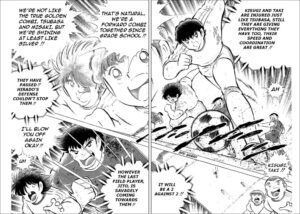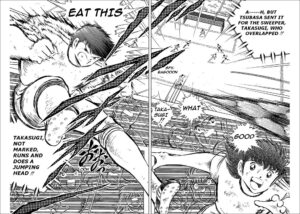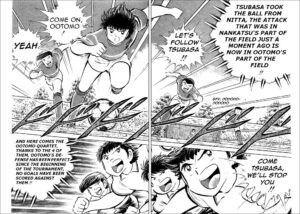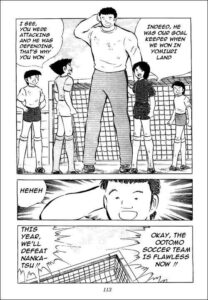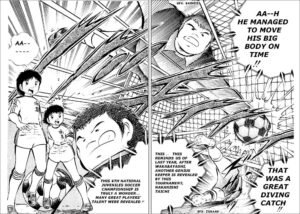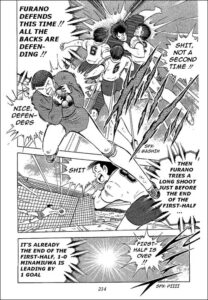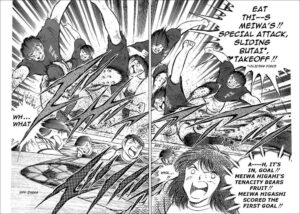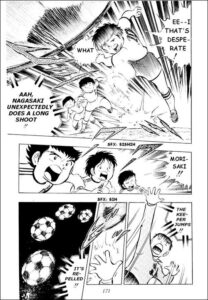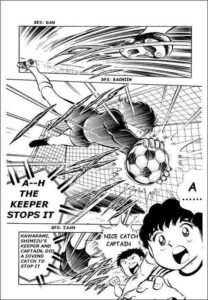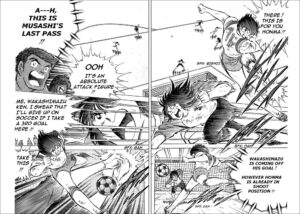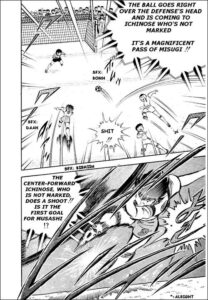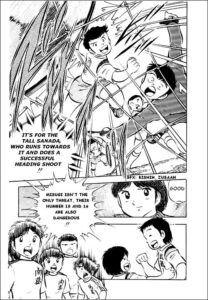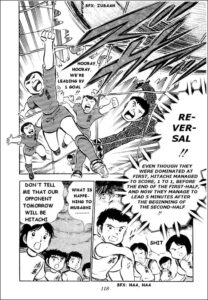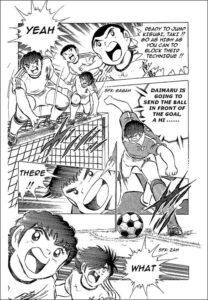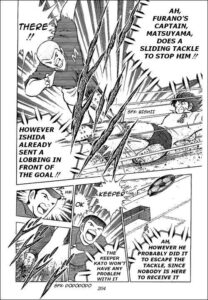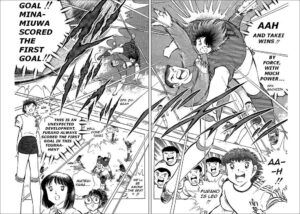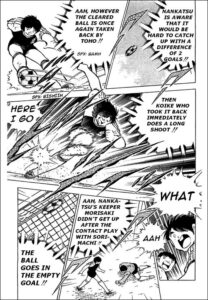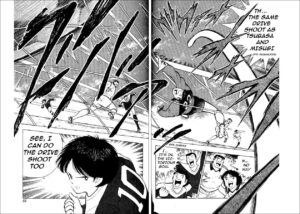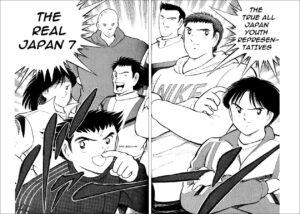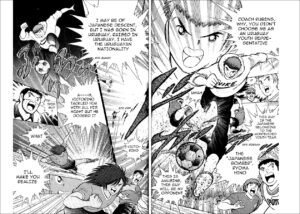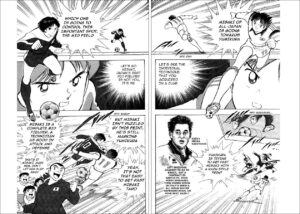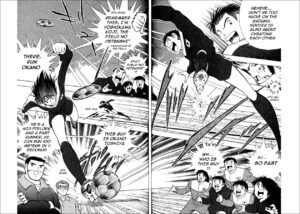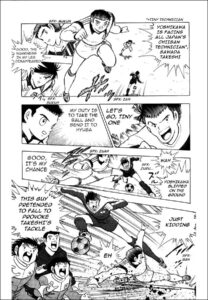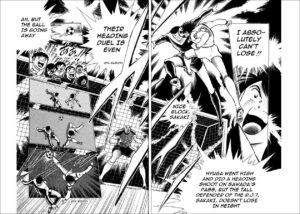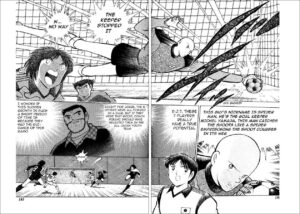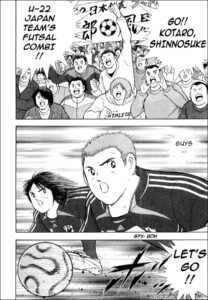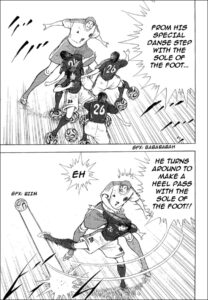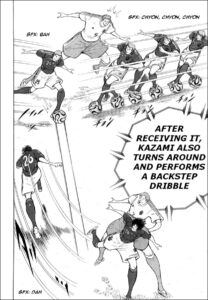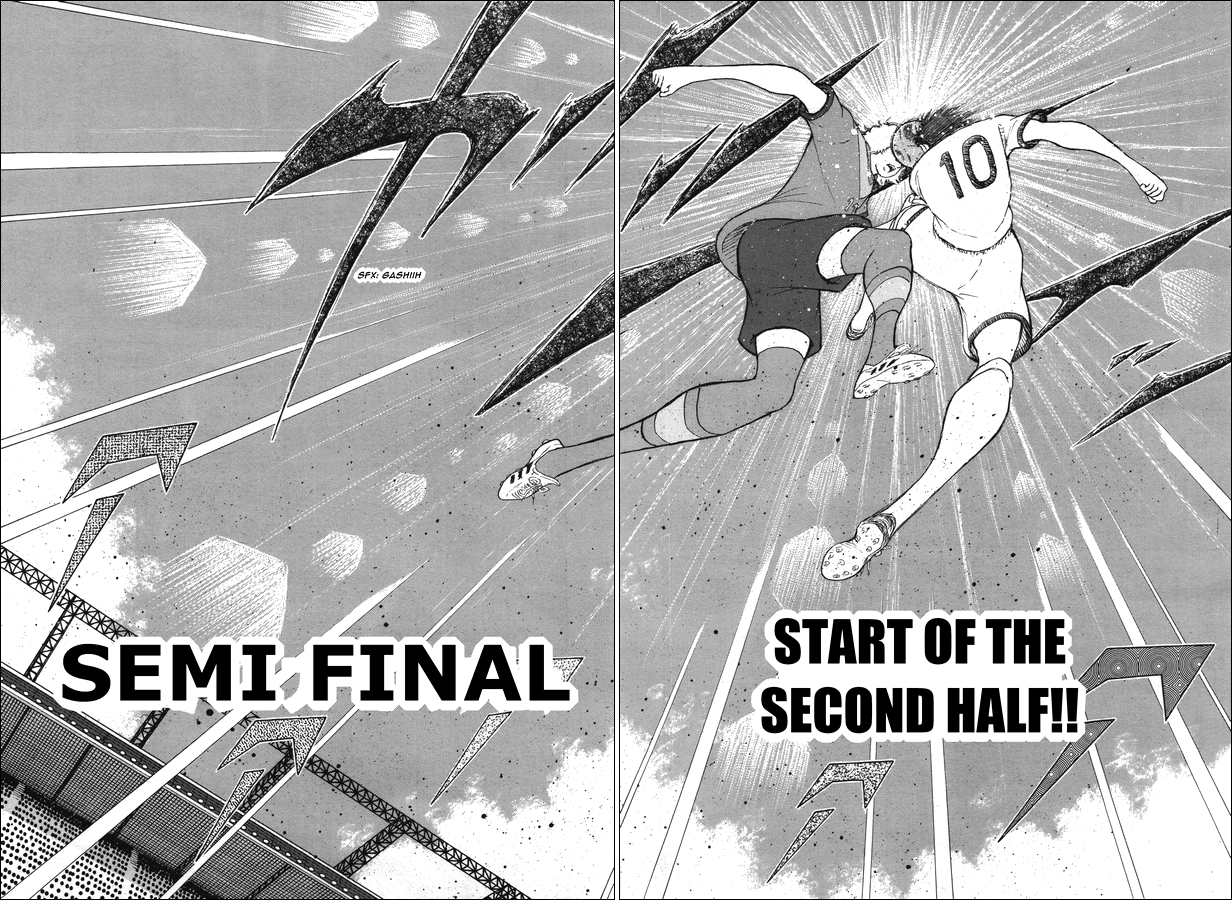Captain Tsubasa, a legendary football anime and manga series, has captured the hearts of fans worldwide with its exhilarating action, intense rivalries, and memorable characters. Among the stars of the manga, there are some players whose appearance left a mark but was never properly revisited again. Here I will be revisiting Japanese players instead of foreign ones.
Kid’s Dream arc (Elementary school)
Shutetsu players like Teppei Kisugi, Hajime Taki and Shingo Takasugi
Kisugi, the striker, Taki, the winger and Takasugi, the giant defender are well liked characters but also very skilled players who have been with the readers since the earliest chapters of the manga. They’ve proven their worth by leading Shutetsu FC with Wakabayashi, Nankatsu SC and Nankatsu MS with Tsubasa to numerous victories. However, as the manga introduced international competitions, their appearances on the field became less frequent. Despite consistently making it to the national team (except for Takasugi, who missed out on the Olympic selection), they were overshadowed by other superior players, including the midfielder of the Shutetsu trio, Izawa as they were benched for the majority of the competitions.
In a sense, they are akin to Dragon Ball’s Yamcha of the series – classic and iconic characters that fans enjoy but who aren’t skilled enough for the international scene. It would have been great if Takahashi had utilized them more in the various manga sequels. Perhaps he could have introduced new techniques for them or created compelling storylines to showcase their growth and development beyond their initial portrayal. These characters had the potential to be more, and fans would have loved to see them shine brightly on the international stage.
Otomo players like Masao Nakayama, Koji Nishio and Isamu Ichijo
Urabe and Kishida, Nakayama and Nishio are also classic characters who’ve won the 6th All-Japan Boys’ Football Tournament with Nankatsu SC. In middle school, they decided to join Otomo and they met Tsubasa’s Nankatsu in the prefecture finals. Both Urabe and Kishida had their playing time in the sequels, especially the former who became part of the Real Japan 11. However, the other two didn’t do anything on the international scene and it would make sense considering their skills. Nakayama made it to the Junior Youth team but never played while Nishio didn’t make it at all. These two aren’t particularly important characters but still, I think Takahashi could have at least let the readers know which professional clubs they were in like with Kishida and Urabe. Fortunately, they do make an appearance in Rising Sun as helpers for the Olympic team, and are considered part of the golden generation. Still, I would have hoped for a little more.
Ichijo. the giant keeper played for Nankatsu SC along with Nitta after Tsubasa had already gone to middle school. Both of them faced off against Sawada‘s Meiwa FC in the finals of the 8th All-Japan Boys’ Football Tournament and won. Ichijo’s goalkeeping abilities along with Nitta’s striking capabilities led the team to victory. He too along with Nitta eventually joined Urabe and co in Otomo to face Tsubasa and Nankatsu in the prefecture finals. While he was never selected to be part of any national squad, he still showed up in Rising Sun cheering on Morisaki. It would have been nice to know if he’s still playing football at a professional level like the rest of his pals from Otomo.
Naniwa’s giant keeper, Taichi Nakanishi
Taichi Nakanishi made an impactful debut as a potential rival goalkeeper to Wakabayashi during the elementary school tournament. However, when his team, Naniwa FC, faced off against Nankatsu, it became apparent that he couldn’t come close to matching Wakabayashi’s level, or even Wakashimazu’s, as his team, Naniwa FC suffered a 5-1 defeat against them. In the middle school arc, his team also fell short in the Osaka finals against the formidable newcomer team, Azuma-ichi, led by Soda.
Despite these setbacks, Nakanishi was still considered a competent goalkeeper, as evidenced by his selection for the U-22 Japan team in a friendly against Denmark. Sadly, Takahashi benched him and instead relied on Morisaki as the third goalkeeper again. It’s disappointing that this didn’t happen as it could have been the perfect opportunity considering the low stakes to showcase Nakanishi’s growth over the years.. There was some potential in his development especially in the mental, as he lost against Nankatsu because he lost his cool after being scored on.
Furano players like Kazumasa Oda, Masanori Kato and others
Oda serves as Furano’s forward. During his time at Furano ES, he displayed decent skills but never stood out, as the team relied heavily on their captain, Matsuyama, to carry them forward. In Furano MS, Oda faced a tough match against Minamiuwa where he struggled to score, but with Matsuyama’s unwavering belief in him, he eventually scored.
Oda eventually managed to secure a place in the J-League club, Consadole Sapporo, alongside his former captain, Matsuyama. Remarkably, he even earned a spot on the Olympic team as a backup member, although he didn’t get a chance to play due to the presence of more skilled players ahead of him, similar to Kisugi and Taki. Though not abandoned per se, he remains included in this list due to limited appearances for the national team, discounting the non-canon anime movies.
As for the goalkeeper, Kato, he was selected for the All Japan Junior Youth training camp but missed out on making it to the final team. As a character, there isn’t much to elaborate on; he is a decent keeper. He later made a cameo appearance in Rising Sun, supporting Morisaki along with other keepers. It would have been nice to see Kato’s development also in a J-League club as with Oda.
Lastly, we have Shuichi Yamamuro, the other forward who made it to the training camp for U-22 Japan.
Meiwa players like Noboru Sawaki and others
During the middle school arc, Hyuga, Sawada, and Wakashimazu made a significant move by leaving their old school club, Meiwa FC, for Toho FC, leaving many of their teammates behind. Among those left behind was Sawaki, who had been a forward alongside Hyuga. Initially a minor character with little involvement in the elementary school arc, Sawaki’s fortunes took a turn when Meiwa’s former star players departed, catapulting him into the role of the top forward for the new school club, Meiwa-Higashi MS in the Middle School arc. Eventually, along with his new captain, Narita and old teammates, Sawaki found themselves facing their former teammates, Sawada and Wakashimazu, in the semi-finals against Toho.
Sawaki’s talents were recognized when he was selected to be part of the training camp of All Japan Jr. Youth. Despite his best efforts, he didn’t secure a spot on the team. Sadly, this marked Sawaki’s final appearance in the manga, as he never managed to make it to any subsequent training camps again. Takahashi had simply forgotten about him.
These other notable Meiwa characters were abandoned because they didn’t amount to much in the first place. These players are:
- Horimichi Hori, the midfielder who was selected to be part of the training camp for All Japan Junior Youth but to be never seen again.
- Motoharu Nagano, the defender who was among the best defenders of the 6th All-Japan Boys’ Football Tournament. He made it to the training camp for U-22 Japan
- Shinichi Sakamoto, the other midfielder who made it to the training camp for U-22 Japan.
Although seeing them playing professionally in a club would have been cool for the fans.
Shimada’s Junichi Nagasaki
Nagasaki faced off against Nankatsu Soccer Club in the semi-finals of the Shizuoka Prefecture tournament during the elementary school arc. While Nagasaki’s skills might not have been extraordinary, he still managed to impress by scoring two goals against an unmotivated Morisaki. What set him apart was his ability to rally his team when they were trailing, proving to be a big challenge for Tsubasa and his teammates.
Nagasaki’s leadership style was commendable as he emphasized the importance of teamwork over individual skills, much like Matsuyama and Furano. In many ways, Shimada and Nagasaki mirrored the dynamics seen with Matsuyama and Furano. The character was not revisited by Takahashi, and instead as Matsuyama became the poster boy for the message of hard work over talent. While I don’t think Takahashi should bring back the character in any significant manner, a cameo would have been appreciated.
Shimizu’s genius keeper, Morimichi Kawakami
Kawakami, the captain of Shimizu, was a good goalkeeper who led his team to the finals in the Shizuoka championship. Despite his team losing to Tsubasa’s Nankatsu in the finals, Kawakami proved to be a decent challenge. While he may not have been on Wakabayashi or Wakashimazu’s level as a keeper, he showcased his value as a good tactician by providing instructions to his teammates during games.
Weirdly enough, , Kawakami’s presence in the middle school arc was virtually nonexistent, and he only made one cameo appearance in the latest arc, Rising Sun cheering on Morisaki during the Olympic quarter finals between Japan and Germany. However, Takahashi brought him back as Shimizu’s goalkeeper in the spinoff “Captain Tsubasa Memories,” which is set before the events of the original manga. So, technically, he wasn’t entirely abandoned, but it does raise questions about why a player of his skills and abilities never made any other footballing appearance after the elementary school arc.
Musashi forwards, Minoru Honma, Akira Ichinose and Shinji Sanada
Upon their introduction, it became evident that Honma, Ichinose and Sanada possessed above average skills, putting them on par with the renowned Shutetsu Trio (Kisugi, Taki, and Izawa). Whenever their captain, Misugi, was absent from the field, they stepped up and carried the team, displaying good potential in their matches against Nankatsu SC and later against Hyuga’s Toho.
While playing alongside their captain, they exhibited an impressive ability to follow precise instructions, making them an indispensable support for him. Notably, Honma was eventually selected to join the Japan Youth team although he didn’t play any match. Unfortunately, the career of the other two players remain unknown since the conclusion of the original manga as they haven’t appeared since. It would have been truly gratifying to witness all three of them thriving together in a J-League club.
Hitachi’s Jiro Osato
Osato is named among the best players of the 6th All-Japan Boys’ Football Tournament. However, there’s a problem. In the match between Musashi and Hitachi, his name was never called. Although he could have been any of the three players below, speculation points towards the one raising his arm, a character who reappears later, cheering on Japan against West Germany. Perhaps it is time for Takahashi to unveil this mini enigma – just a thought.
Boy’s Fight arc (Middle school)
Hanawa’s substitute defender, Yuichiro Daimaru
In the second half of the match between Nankatsu MS and Hanawa MS, Daimaru made his entrance onto the field. As a towering defender akin to Jito, he possessed an immensely powerful kick. Daimaru’s formidable kicking ability proved instrumental in improving their new technique, the Skylab Hurricane, by propelling the ball high into the air.
Considering some of his involvement in the original Skylab Hurricane technique, which holds great significance for fans of the series, it’s rather astonishing that Daimaru never made any subsequent appearances, not even as a brief cameo.
Minamiuwa’s duo, Tetsuo Ishida and Kazuto Takei
Ishida, the captain of Minamiuwa, posed a significant challenge for Matsuyama and his team. Beyond his good dribbling technique, what stood out was his attitude, which contradicted the manga’s message of teamwork. During the match, he told Matsuyama that he cannot rely on his teamates. However, Ishida’s prediction was proven wrong when Furano secured victory, thanks to Matsuyama’s unwavering belief in his forward, Kazumasa Oda, who scored the decisive goal.
Takei, the towering forward of Minamiuwa, was a force to be reckoned with on the field. Teaming up with Ishida, they became a fearless duo that gave Furano some trouble. Takei’s exceptional header skills were particularly impressive, and he demonstrated it by scoring against Furano’s top goalkeeper, Kato.
Both of them were selected to participate in the junior training camp for All Japan Jr. Youth but failed to secure a spot in the top 23. Despite this setback, they showed their sportsmanship and wished Matsuyama and the rest of the selected players all the best. Like Sawaki, Ishida and Takei were never seen again in the manga. I think Takahashi could have at least shown them in the subsequent training camps afterwards in the sequels to show that they’re still playing football at a professional level. As always, showing them playing a J-League club to play would have been great for fans.
Toho’s midfielder, Hideto Koike
Koike a midfielder playing for Toho, possessed decent skills and frequently provided support to Sawada in the midfield. Although he was chosen to participate in the training camp for All Japan Junior Youth, he didn’t ultimately make it to the final team. Beyond his distinctive beady eyes, there isn’t much else to note about him as a character. Regrettably, he didn’t make any further appearances in the manga, leaving his future in football uncertain. It would have been interesting to see him at least being selected for the subsequent training camps.
Battle for World Youth arc
All Japan’s Youth and Wakashimazu’s replacement keeper, Kenta Sasaki
Sasaki participated in the All Japan youth selection test and he was taken alongside Misugi showing that he must have been a decent keeper. He replaced an injured Morisaki against the RJ7 but got scored on multiple times by Yumikura. This character didn’t need to exist as Takahashi could have picked Nakanishi or any other known Japanese keepers. He was rightfully abandoned subsequently.
Real Japan 11 / Real Japan 7
To strengthen Tsubasa and the players of All Japan Youth for the World Youth tournament, the coach Gamo devised a unique approach by forming a “shadow” Japan Youth team to act as a practice squad for the official All Japan Youth team. Initially consisting of 11 players, the team encountered some changes when Igawa, Soga, Furukawa, and Kazami departed for various reasons. As a result, it transformed into the “Real Japan 7.”
Ryoma Hino
The team’s star player and primary forward, Hino held dual Japanese and Uruguayan nationality, ultimately choosing to represent Uruguay in the World Youth tournament instead of Japan. However, in my view, this decision might not have been the best one, as Uruguay didn’t appear in the Olympic arc, Rising Sun. Other stronger and more significant national teams took precedence, which deprived readers of witnessing his character development.
Thankfully, there is a silver lining, as he makes a triumphant return in the video game arc, Next Dream, providing some hope to fill the gap left by Takahashi’s narrative choices.
Nobyuki Yumikura
Yumikura was introduced as a rival to Taro Misaki’s replacement in the midfield. He was already playing in a J-League club at the time of his introduction. He even had the ability to execute Tsubasa’s iconic drive shoot, making him a promising player. Yumikura earned the opportunity to represent Japan in a friendly match against Denmark during the second half, although his on-field actions weren’t showcased to the readers. However, shortly afterward, he was unexpectedly dropped from the Olympic squad.
Toshiyo Okano, Takashi Sugimoto, Yuji Sakaki and Michel Yamada
Each of them showcased remarkable skills – Okano rivaling Nitta’s speed, Sugimoto/Yoshikawa displaying his dribble tricks, Sakaki, a towering defender adept at Jito’s role, and Yamada, the exceptional spider keeper, clearly surpassing Morisaki’s own abilities at the time. Additionally, all of them went on to play professionally in a Japanese club.
These talented individuals were invited to the training camp for the Asian preliminaries for the Olympics. Although they didn’t secure a spot in the final team, it’s understandable considering the vast number of candidates vying for selection. That said, Takahashi could have given them more character development by having them interact with the main team in Rising Sun, as cheerleaders or otherwise.
Golden 23 arc
The Futsal duo, Kotaro Furukawa and Shinnosuke Kazami
Furukawa & Kazami initially earned spots on the Olympic team during the early stages of the Asian preliminaries. Despite their desire to continue playing football professionally, they faced disappointment as no J-League club extended invitations. Consequently, they opted to pursue futsal instead. Eventually, coach Gamo extended an invitation to have them join the RJ11, though they were initially reluctant to accept. However, after some persuasion, they finally joined the team.
Later, Olympic Coach Kira decided to include them in the training camp for the Asian preliminaries selection, and they successfully secured spots on the team. Their futsal background brought a unique dimension to the squad, enhancing their football gameplay with distinctive skills. Nevertheless, one of their Japanese teammates, Sano, learned and adapted their futsal techniques, rendering their presence somewhat unneeded for the final stages of the preliminaries.
With the return of Japan’s main soccer stars for the Olympics, they unfortunately missed out on the final Olympic selection. Despite this, their exceptional futsal techniques showcased something unique for the manga, so I hope they return in some capacity in the future, hopefully in Next Dream.
Those were the interesting characters that appeared in Captain Tsubasa. Some might wonder about the international players like the English international, Steve Robson and it’s fair to say many of them were abandoned by the author too, but also it’s understandable due to the sheer amount of characters Captain Tsubasa has. Maybe I’ll do an article on these international players, until then, see you next time! The manga panels are all from Shinji’s scanlations which can be found here.
Credit: Captain Tsubasa by Yoichi Takahashi
Read my other Captain Tsubasa articles
Captain Tsubasa Manga Reading Order
Captain Tsubasa Rising Sun THE FINAL: Chapter 1 & 2 Review
Captain Tsubasa Rising Sun THE FINAL: Chapter 3 & 4 Review
Exploring Tecmo’s Captain Tsubasa video games and their enduring appeal


